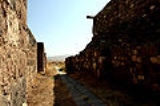
Konstantine Hovhannisyan
Encyclopedia
Konstantine Hovhannisyan was an Armenian
professor
, architect
and archaeologist. He was the head of an excavation team that was responsible for the excavations of the ancient Urartian city of Erebuni
(situated on Arin Berd, or Blood Fortress, in Yerevan
).
 Hovhannisyan was born in Tiflis, Georgia
Hovhannisyan was born in Tiflis, Georgia
in 1911. He graduated from the Yerevan
Polytechnical Institute in 1932 and immediately began to work under the Armenian architects Alexander Tamanian
and Nicholas G. Buniatyan (from 1933–1934 and 1934–1941, respectively). As an architect, Hovhannisyan designed many of the Soviet-style apartment buildings and community facilities that sprang around the city of Yerevan.
In 1950, he was appointed the director of an excavation team that dug up the ancient Urartian fortress of Erebuni
, located to the southeast of modern-day Yerevan. It was Hovhannisyan who had initially identified Arin Berd as the location of Erebuni, based on inscriptions found adjacent to the city. Hovhannisyan used what was left of Erebuni as a basis for reconstructing the fortress and how it would have looked like when it was built in 782 B.C.
Excavations of Erebuni continued for several decades and he remained its director until 1969. Hovhannisyan served as Director of Ancient Monuments in the Armenian SSR
from 1952 to 1979. He was also a professor at his alma mater
, teaching at the Yerevan Polytechnical Institute
from 1955 to 1971.
Armenians
Armenian people or Armenians are a nation and ethnic group native to the Armenian Highland.The largest concentration is in Armenia having a nearly-homogeneous population with 97.9% or 3,145,354 being ethnic Armenian....
professor
Professor
A professor is a scholarly teacher; the precise meaning of the term varies by country. Literally, professor derives from Latin as a "person who professes" being usually an expert in arts or sciences; a teacher of high rank...
, architect
Architect
An architect is a person trained in the planning, design and oversight of the construction of buildings. To practice architecture means to offer or render services in connection with the design and construction of a building, or group of buildings and the space within the site surrounding the...
and archaeologist. He was the head of an excavation team that was responsible for the excavations of the ancient Urartian city of Erebuni
Erebuni
Erebuni may refer to:*Erebuni Fortress, the fortress of ancient kingdom of Urartu, now territory of Armenia*Yerevan, capital of Armenia*Erebuni, Armenia, a district of Yerevan*Erebuni Museum*Erebuni Airport...
(situated on Arin Berd, or Blood Fortress, in Yerevan
Yerevan
Yerevan is the capital and largest city of Armenia and one of the world's oldest continuously-inhabited cities. Situated along the Hrazdan River, Yerevan is the administrative, cultural, and industrial center of the country...
).
Biography

Georgia (country)
Georgia is a sovereign state in the Caucasus region of Eurasia. Located at the crossroads of Western Asia and Eastern Europe, it is bounded to the west by the Black Sea, to the north by Russia, to the southwest by Turkey, to the south by Armenia, and to the southeast by Azerbaijan. The capital of...
in 1911. He graduated from the Yerevan
Yerevan
Yerevan is the capital and largest city of Armenia and one of the world's oldest continuously-inhabited cities. Situated along the Hrazdan River, Yerevan is the administrative, cultural, and industrial center of the country...
Polytechnical Institute in 1932 and immediately began to work under the Armenian architects Alexander Tamanian
Alexander Tamanian
Alexander Tamanian was a Russian-born Armenian neoclassical architect, who is remembered today for his work in the city of Yerevan.Born in the city of Yekaterinodar in 1878 in the family of a banker. He graduated from the St Petersburg Academy of Arts in 1904. His works portrayed sensitive and...
and Nicholas G. Buniatyan (from 1933–1934 and 1934–1941, respectively). As an architect, Hovhannisyan designed many of the Soviet-style apartment buildings and community facilities that sprang around the city of Yerevan.
In 1950, he was appointed the director of an excavation team that dug up the ancient Urartian fortress of Erebuni
Erebuni
Erebuni may refer to:*Erebuni Fortress, the fortress of ancient kingdom of Urartu, now territory of Armenia*Yerevan, capital of Armenia*Erebuni, Armenia, a district of Yerevan*Erebuni Museum*Erebuni Airport...
, located to the southeast of modern-day Yerevan. It was Hovhannisyan who had initially identified Arin Berd as the location of Erebuni, based on inscriptions found adjacent to the city. Hovhannisyan used what was left of Erebuni as a basis for reconstructing the fortress and how it would have looked like when it was built in 782 B.C.
Excavations of Erebuni continued for several decades and he remained its director until 1969. Hovhannisyan served as Director of Ancient Monuments in the Armenian SSR
Armenian SSR
The Armenian Soviet Socialist Republic The Armenian Soviet Socialist Republic The Armenian Soviet Socialist Republic The Armenian Soviet Socialist Republic The Armenian Soviet Socialist Republic The Armenian Soviet Socialist Republic The Armenian Soviet Socialist Republic The Armenian Soviet...
from 1952 to 1979. He was also a professor at his alma mater
Alma mater
Alma mater , pronounced ), was used in ancient Rome as a title for various mother goddesses, especially Ceres or Cybele, and in Christianity for the Virgin Mary.-General term:...
, teaching at the Yerevan Polytechnical Institute
State Engineering University of Armenia
The State Engineering University of Armenia is a technical university located in Yerevan, Armenia. Established as the Yerevan Polytechnic Institute in 1933, it provides educational and research programs in various fields of technology and science related to engineering...
from 1955 to 1971.
Published works
Oganesian, K. L. Arin-Berd I. Arkhitektura Erebuni po materialam raskopok 1950-59 (Arin-Berd I. The Architecture of Erebuni according to excavated materials from 1950–59). Yerevan: Akademi Nauk Armianskoy SSR, 1961. Karmir Blur IV. Arkhitektura Teishabaini. Yerevan, Akademi Nauk Armianskoy SSR, 1955.- The Wall Paintings of Erebuni. Yerevan, 1973. The Restoration of Architectural Monuments in Soviet Armenia. Yerevan, 1978. Ocherki po istorii arkhitektur drevney i srednevekovoy Armenii. Yerevan, 1978.

